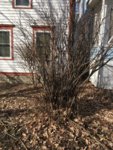Mike Hennigan
Chumono
So I have an old Japanese quince growing in my yard. This is not Chojubai, but more of a standard landscape variety, with coarser growth. It’s lovely in the spring when it is covered with gorgeous red flowers but other than that it is a pretty ugly landscape shrub.
My questions are: Does anyone have experience working with the “normal” Japanese quince varieties like this one? Do these varieties have potential as bonsai? Do the leaves reduce at all once grown in bonsai culture?
Basically I am going to be digging out and removing this quince from my yard and replacing it with a nice landscape lace leaf JM. So it is going either way. I would prefer to plant the Japanese maple this fall instead of waiting til the spring since planting trees and shrubs in the landscape is always better to do in the fall. So if I decide to keep the quince I will wait until the leaves start to change color, dig it out of the ground with a sizable rootball, burlap the rootball and mulch it in for the winter. Leaving the rootball undisturbed. In the spring I would go back and open up the root ball and remove the field soil to pot up the many trunks. I think this should work fine and that way I can get the JM in the ground this fall.
This past spring I decided to prune it back very hard, though the trunks are taller than they appear to be in the photo. Before and after pics.



And a couple pics from today, after pushing strong growth all summer:


The bottom line is that I already have a lot of bonsai trees to look after and I don’t want to waste my time if working with this variety won’t be rewarding. Though I do have a lot of taller wider trunks in this clump (this bush has probably been planted here for at least 50 years) so I think that can work to balance out the coarse growth. Also I’m not totally sure what I will find when I open up the rootball. Will these trunks be strongly fused to each other or will they separate easily? Either way there’s a lot of trunks in this clump so I could come out of this with some gnarly clump style trees or have more than enough trunks to put together a few quince forests. Thanks in advance for any advice or insight!





My questions are: Does anyone have experience working with the “normal” Japanese quince varieties like this one? Do these varieties have potential as bonsai? Do the leaves reduce at all once grown in bonsai culture?
Basically I am going to be digging out and removing this quince from my yard and replacing it with a nice landscape lace leaf JM. So it is going either way. I would prefer to plant the Japanese maple this fall instead of waiting til the spring since planting trees and shrubs in the landscape is always better to do in the fall. So if I decide to keep the quince I will wait until the leaves start to change color, dig it out of the ground with a sizable rootball, burlap the rootball and mulch it in for the winter. Leaving the rootball undisturbed. In the spring I would go back and open up the root ball and remove the field soil to pot up the many trunks. I think this should work fine and that way I can get the JM in the ground this fall.
This past spring I decided to prune it back very hard, though the trunks are taller than they appear to be in the photo. Before and after pics.



And a couple pics from today, after pushing strong growth all summer:


The bottom line is that I already have a lot of bonsai trees to look after and I don’t want to waste my time if working with this variety won’t be rewarding. Though I do have a lot of taller wider trunks in this clump (this bush has probably been planted here for at least 50 years) so I think that can work to balance out the coarse growth. Also I’m not totally sure what I will find when I open up the rootball. Will these trunks be strongly fused to each other or will they separate easily? Either way there’s a lot of trunks in this clump so I could come out of this with some gnarly clump style trees or have more than enough trunks to put together a few quince forests. Thanks in advance for any advice or insight!





Last edited:



